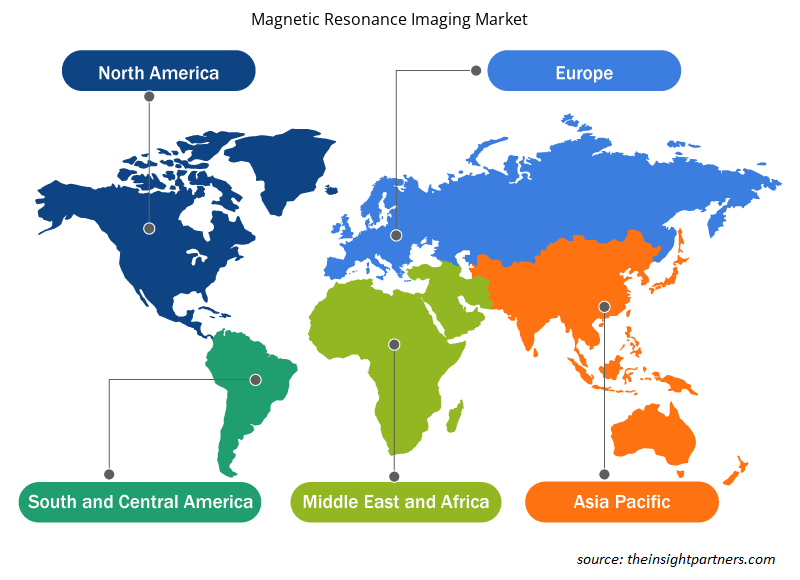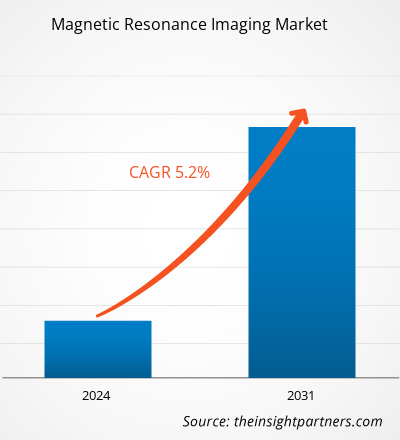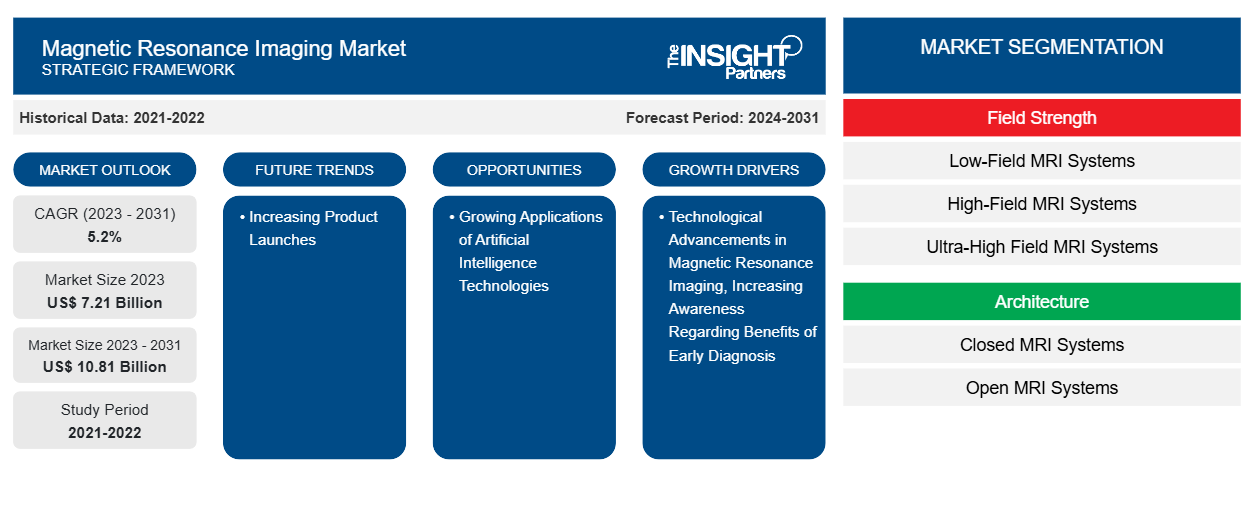Si prevede che la dimensione del mercato della risonanza magnetica per immagini raggiungerà i 10,81 miliardi di dollari entro il 2031, rispetto ai 7,21 miliardi di dollari del 2023. Si prevede che il mercato registrerà un CAGR del 5,2% nel 2023-2031. Le crescenti applicazioni delle tecnologie di intelligenza artificiale rappresentano una delle principali tendenze del mercato della risonanza magnetica per immagini.
Analisi del mercato della risonanza magnetica
L'aumento dell'invecchiamento della popolazione, l'aumento del numero di persone affette da cancro, i progressi tecnici nel campo dell'assistenza sanitaria che portano all'innovazione di tecnologie nuove e all'avanguardia e la crescente consapevolezza dell'importanza della diagnosi precoce delle malattie, che aiuta nel trattamento precoce, sono alcuni fattori che stanno espandendo la crescita del mercato. Si prevede che un aumento degli investimenti che porti all'introduzione di nuovi prodotti e progetti finanziati per migliorare le tecnologie MRI nell'assistenza pediatrica aumenteranno l'espansione del mercato durante il periodo di previsione.
Panoramica del mercato della risonanza magnetica
La risonanza magnetica per immagini (RMI) è un sistema di imaging diagnostico non invasivo che utilizza forti campi magnetici e onde radio per generare immagini dettagliate dell'interno del corpo. Gli agenti di contrasto impiegati nella RM aiutano a distinguere tra tumori benigni e maligni in base al tipo di lesioni prodotte. Con l'aumento delle malattie croniche nei paesi sviluppati e in via di sviluppo, la richiesta di imaging medico è cresciuta notevolmente. Secondo il GLOBOCAN Report 2020, sono stati segnalati circa 19,29 milioni di nuovi casi di cancro a livello globale, insieme a 9,95 milioni di decessi segnalati causati dalla malattia. Secondo i dati delle statistiche sanitarie dell'OCSE, sono installati 50.000 sistemi RM in tutto il mondo e vengono eseguite oltre 95 milioni di scansioni RM ogni anno a livello globale. Ad aprile 2021, Philips ha partecipato a un progetto di ricerca fondamentale per scoprire un uso potenzialmente rivoluzionario della tecnologia RM in cardiologia.
Personalizza questo report in base alle tue esigenze
Riceverai la personalizzazione gratuita di qualsiasi report, comprese parti di questo report, o analisi a livello nazionale, pacchetto dati Excel, oltre a usufruire di grandi offerte e sconti per start-up e università
-
Scopri le principali tendenze di mercato in questo rapporto.Questo campione GRATUITO includerà analisi di dati che spaziano dalle tendenze di mercato alle stime e alle previsioni.
Driver e opportunità del mercato della risonanza magnetica
I progressi tecnologici nell'imaging a risonanza magnetica guidano la crescita del mercato
La risonanza magnetica è una delle modalità di imaging diagnostico più flessibili, in grado di caratterizzare un'ampia gamma di parametri nel soggetto vivente e di fornire una risoluzione spaziale squisita. Diversi recenti sviluppi tecnologici hanno segnato l'evoluzione delle tecniche di risonanza magnetica negli ultimi anni. Alcuni dei progressi tecnologici includono l'introduzione della risonanza magnetica aperta, che facilita l'imaging efficiente di individui sovrappeso o claustrofobici. Questi progressi hanno anche migliorato l'intensità di campo e la capacità di calcolo dell'apparecchiatura di imaging. Grazie a queste caratteristiche, le sequenze di impulsi dell'apparecchiatura sono state migliorate, con conseguente tempistica di imaging più rapida, risoluzione spaziale più elevata e migliore qualità di imaging. Prodotti nuovi e tecnologicamente avanzati offerti dai principali attori del mercato, come MAGNETOM Terra di Siemens, il primo sistema MRI da 7T autorizzato per l'uso clinico, sono alcuni dei progressi tecnologici intrapresi dagli attori del mercato affermati e dai nuovi entranti per migliorare la qualità e l'efficacia delle scansioni MRI che stanno guidando la crescita del mercato.
Aumento dei lanci di prodotti per favorire la crescita del mercato
Il crescente numero di lanci di prodotti, unito alla crescente adozione di sistemi ad alta resistenza, è una delle principali opportunità offerte ai player del mercato. Le innovazioni tecnologiche hanno portato allo sviluppo e alla successiva commercializzazione di apparecchiature di imaging ad alta resistenza. Nell'agosto 2023, il ministro dell'Unione Dr. Jitendra Singh ha presentato a Nuova Delhi il primo scanner MRI di nuova generazione ad alto campo (1,5 Tesla) leggero, ultraveloce, conveniente e sviluppato in India. Nell'ambito della National Biopharma Mission del Dipartimento di biotecnologia, la startup con sede a Bengaluru Voxelgrids Innovations Pvt Ltd ha sviluppato uno scanner MRI compatto per risolvere l'esigenza insoddisfatta del Paese.
Analisi della segmentazione del rapporto di mercato sulla risonanza magnetica
I segmenti chiave che hanno contribuito alla derivazione dell'analisi di mercato della risonanza magnetica sono l'intensità del campo, l'architettura, l'applicazione e l'utente finale.
- In base all'intensità del campo, il mercato della risonanza magnetica per immagini è suddiviso in sistemi MRI a basso campo, sistemi MRI ad alto campo e sistemi MRI a campo ultra-alto. Il segmento dei sistemi MRI ad alto campo ha detenuto la quota di mercato maggiore nel 2023. Inoltre, si prevede che il segmento dei sistemi MRI a basso campo registrerà il CAGR più elevato durante il periodo di previsione.
- In termini di architettura, il mercato è categorizzato in sistemi MRI chiusi e sistemi MRI aperti. Il segmento dei sistemi MRI chiusi ha detenuto la quota di mercato più grande nel 2023. Inoltre, si prevede che il segmento dei sistemi MRI aperti registrerà il CAGR più elevato durante il periodo di previsione.
- In termini di applicazione, il mercato è categorizzato in cardiologia, oncologia, neurologia, gastroenterologia, muscoloscheletrico, altri. Il segmento neurologico ha detenuto la quota di mercato più grande nel 2023. Inoltre, si prevede che il segmento muscoloscheletrico registrerà il CAGR più elevato durante il periodo di previsione.
- In base all'utente finale, il mercato della risonanza magnetica è segmentato inospedali, centri chirurgici ambulatoriali e centri diagnostici. Il segmento ospedaliero ha detenuto la quota di mercato maggiore nel 2023 e si stima che registrerà il CAGR più elevato durante il periodo di previsione.
Analisi della quota di mercato della risonanza magnetica per area geografica
L'ambito geografico del rapporto sul mercato della risonanza magnetica per immagini è suddiviso principalmente in cinque regioni: Nord America, Asia Pacifico, Europa, Medio Oriente e Africa, Sud e Centro America.
Il Nord America ha dominato il mercato della risonanza magnetica. L'aumento della domanda di prodotti innovativi da parte di aziende biofarmaceutiche e di risonanza magnetica, la presenza di attori di mercato cruciali e un'ampia R&S condotta da numerosi istituti accademici e di ricerca favoriscono la crescita del mercato nella regione. Inoltre, la crescente attenzione all'incorporazione di metodi avanzati nell'assistenza sanitaria e l'elevato volume di procedure di imaging a causa della crescente prevalenza di malattie croniche stimolano ulteriormente la crescita del mercato nel Nord America.
Si prevede che l'Asia Pacifica crescerà con il CAGR più elevato nei prossimi anni. La crescente adozione di sistemi innovativi, una solida potenziale base di pazienti e una crescente consapevolezza sulla diagnostica avanzata per i crescenti casi della malattia sono alcuni dei fattori che probabilmente supporteranno la crescita del mercato nella regione.
Approfondimenti regionali sul mercato della risonanza magnetica
Le tendenze regionali e i fattori che influenzano il mercato della risonanza magnetica per immagini durante il periodo di previsione sono stati ampiamente spiegati dagli analisti di Insight Partners. Questa sezione discute anche i segmenti e la geografia del mercato della risonanza magnetica per immagini in Nord America, Europa, Asia Pacifico, Medio Oriente e Africa e America meridionale e centrale.

- Ottieni i dati specifici regionali per il mercato della risonanza magnetica
Ambito del rapporto di mercato sulla risonanza magnetica
| Attributo del report | Dettagli |
|---|---|
| Dimensioni del mercato nel 2023 | 7,21 miliardi di dollari USA |
| Dimensioni del mercato entro il 2031 | 10,81 miliardi di dollari USA |
| CAGR globale (2023-2031) | 5,2% |
| Dati storici | 2021-2022 |
| Periodo di previsione | 2024-2031 |
| Segmenti coperti |
Per intensità di campo
|
| Regioni e Paesi coperti |
America del Nord
|
| Leader di mercato e profili aziendali chiave |
|
Densità degli operatori del mercato della risonanza magnetica: comprendere il suo impatto sulle dinamiche aziendali
Il mercato della risonanza magnetica per immagini sta crescendo rapidamente, spinto dalla crescente domanda degli utenti finali dovuta a fattori quali l'evoluzione delle preferenze dei consumatori, i progressi tecnologici e una maggiore consapevolezza dei vantaggi del prodotto. Con l'aumento della domanda, le aziende stanno ampliando le loro offerte, innovando per soddisfare le esigenze dei consumatori e capitalizzando sulle tendenze emergenti, il che alimenta ulteriormente la crescita del mercato.
La densità degli operatori di mercato si riferisce alla distribuzione di aziende o società che operano in un particolare mercato o settore. Indica quanti concorrenti (operatori di mercato) sono presenti in un dato spazio di mercato in relazione alle sue dimensioni o al valore di mercato totale.
Le principali aziende che operano nel mercato della risonanza magnetica sono:
- Assistenza sanitaria GE
- Koninklijke Philips NV
- Siemens AG
- Società di sistemi medici Canon
- Esaote SpA
- FONAR
Disclaimer : le aziende elencate sopra non sono classificate secondo un ordine particolare.

- Ottieni una panoramica dei principali attori del mercato della risonanza magnetica
Notizie e sviluppi recenti sul mercato della risonanza magnetica
Il mercato della risonanza magnetica per immagini viene valutato raccogliendo dati qualitativi e quantitativi post-ricerca primaria e secondaria, che includono importanti pubblicazioni aziendali, dati di associazioni e database. Di seguito è riportato un elenco di sviluppi nel mercato della biodifesa e delle strategie:
- Siemens Healthineers ha inaugurato il nuovo stabilimento di produzione per macchine MRI a Bengaluru. Attualmente l'azienda produce MAGNETOM Free. Star, un approccio semplice e dirompente alla MRI di alta qualità in India. (Fonte: Siemens Healthineers, comunicato stampa, 2023)
- FUJIFILM Healthcare Americas Corp. ha ricevuto l'autorizzazione FDA 510(k) per il suo nuovo sistema MRI da 1,5 Tesla, ECHELON Synergy. Il sistema impiega la ricostruzione di apprendimento profondo Synergy (DLR), la tecnologia DLR proprietaria di Fujifilm basata sull'intelligenza artificiale, per migliorare la nitidezza delle immagini e acquisire scansioni più velocemente, contribuendo a una maggiore produttività, qualità delle immagini e soddisfazione del paziente. (Fonte: FUJIFILM Holdings America Corporation, comunicato stampa, 2023)
Copertura e risultati del rapporto sul mercato della risonanza magnetica
Il rapporto "Dimensioni e previsioni del mercato della risonanza magnetica (2021-2031)" fornisce un'analisi dettagliata del mercato che copre le seguenti aree:
- Dimensioni e previsioni del mercato a livello globale, regionale e nazionale per tutti i segmenti di mercato chiave coperti dall'ambito
- Dinamiche di mercato come fattori trainanti, vincoli e opportunità chiave
- Principali tendenze future
- Analisi dettagliata delle cinque forze PEST/Porter e SWOT
- Analisi di mercato globale e regionale che copre le principali tendenze di mercato, i principali attori, le normative e gli sviluppi recenti del mercato
- Analisi del panorama industriale e della concorrenza che copre la concentrazione del mercato, l'analisi della mappa di calore, i principali attori e gli sviluppi recenti
- Profili aziendali dettagliati
- Analisi storica (2 anni), anno base, previsione (7 anni) con CAGR
- Analisi PEST e SWOT
- Valore/volume delle dimensioni del mercato - Globale, Regionale, Nazionale
- Industria e panorama competitivo
- Set di dati Excel
Report recenti
Testimonianze
Motivo dell'acquisto
- Processo decisionale informato
- Comprensione delle dinamiche di mercato
- Analisi competitiva
- Analisi dei clienti
- Previsioni di mercato
- Mitigazione del rischio
- Pianificazione strategica
- Giustificazione degli investimenti
- Identificazione dei mercati emergenti
- Miglioramento delle strategie di marketing
- Aumento dell'efficienza operativa
- Allineamento alle tendenze normative























 Ottieni un campione gratuito per - Mercato della risonanza magnetica
Ottieni un campione gratuito per - Mercato della risonanza magnetica